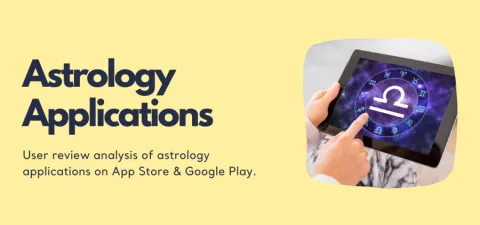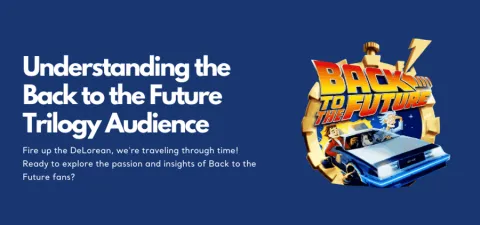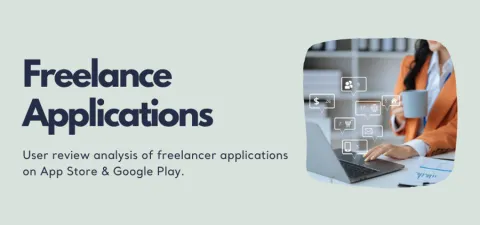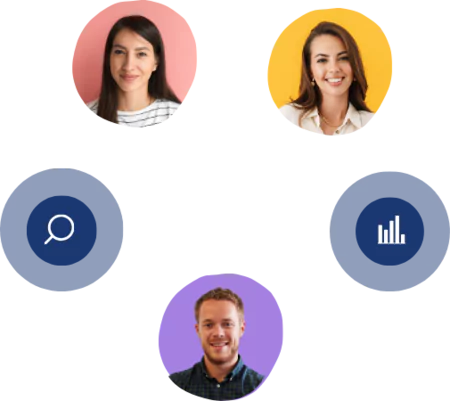Understanding Dating Apps Through Customer Feedback Analysis
Dec 08, 2025 - 16 minute read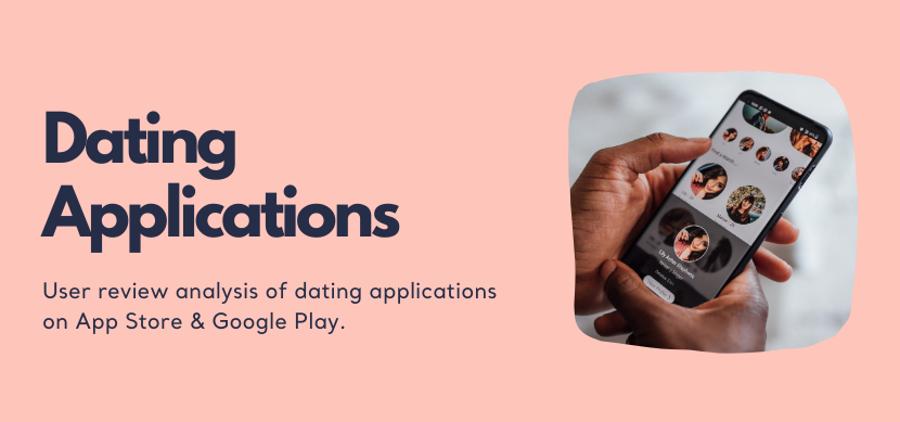
Love, connection, and serendipity—once the stuff of handwritten letters and stolen glances—now unfold through tiny screens in the palm of our hands. The world of dating has changed, bringing people together with a swipe rather than a chance encounter. Of course, there's something romantic about the days of perfume-scented notes and lipstick-sealed letters 💋, or the thrill of passing secret messages in class. But today's love stories are written in DMs, emojis, and carefully crafted profiles.
Yet, does this digital shift truly meet expectations when it comes to romance and emotions? Are dating apps delivering meaningful connections, or do they leave users feeling lost in an endless scroll of possibilities? To find out, we'll take a closer look at three major dating platforms—Tinder, Bumble, and Happn. What do users say about them? What do they love, and what leaves them frustrated? Let's dive into the world of digital dating through the lens of real user experiences.
Methodology
To understand the real user experience in the dating app market, we selected the three most-reviewed applications: Tinder, Bumble, and Happn.
We built a dataset of 1,500 recent customer reviews from both the Google Play Store and the App Store, gathering around 250 of the latest reviews per app on each platform. We analyzed this dataset using Kimola, classifying each review with multiple labels to capture different aspects of the user experience, along with a sentiment for each label. This method allowed us to identify common themes, recurring pain points, and standout features across all three platforms. Additionally, we conducted an analysis to generate Buyer Personas based on user experiences, segmenting users into distinct groups to better understand their motivations, frustrations, and expectations from dating apps.
Each of these apps offers a unique experience. Tinder is known for its massive user base and quick-matching system. Bumble empowers women to make the first move. Happn turns chance encounters into digital connections, weaving a fairy-tale element into modern dating.
But do these apps truly meet users' expectations? What aspects delight or disappoint them? Customer feedback provides the most up-to-date answers to these questions, revealing what users genuinely appreciate, the challenges they face, and whether these platforms deliver on their promises of connection and romance. Let's dive into the insights gathered from real user experiences.
Why Do People Use Dating Apps? Understanding User Motivations
Dating apps have become more than just platforms for romance—they serve multiple purposes, catering to different user needs and expectations. Based on the customer feedback analysis on Kimola, several key motivations drive users to these platforms, highlighting the benefits they provide.
The primary reason people turn to dating apps is for dating and relationship building. These platforms make it easier to find romantic connections by expanding the pool of potential matches beyond immediate social circles. Whether seeking casual dating or long-term relationships, users appreciate the ability to browse and connect with others who share their interests and intentions.
Beyond romance, dating apps serve as a tool for social interaction. Many users turn to these platforms not only to find a partner but also to engage in meaningful conversations, expand their networks, or even form friendships. The digital format allows people to interact with individuals they might not have encountered otherwise, breaking barriers of location and social circles.
The process of profile creation is an essential step in using dating apps, but it often leads to frustration. Users report difficulties in setting up their profiles, including challenges with uploading photos and filling in required details. Once profiles are complete, users rely on match notifications to find potential partners, yet many express dissatisfaction with irrelevant or low-quality matches. This followed by messaging issues where users report frustrations with restrictions on initiating conversations, message time limits, and a lack of engaging communication features. Similarly, filters and preferences play an important role in helping users refine their matches based on criteria such as religion, interests, or lifestyle choices. However, many of these features are locked behind a paywall, leading to frustration among free users. Other than these, users frequently mention difficulties with canceling subscriptions, unexpected charges, and a lack of transparency regarding pricing. For those who travel frequently, travel mode is a useful feature that allows users to connect with people in different locations, though reviews suggest mixed experiences regarding its effectiveness.
Finally, the overall user experience and functionality of dating apps make the process of meeting new people more seamless. The convenience of browsing, matching, and messaging from a mobile device makes dating more accessible than ever. While challenges such as technical glitches or subscription concerns exist, the ability to meet new people, build connections, and explore romantic possibilities remains the core appeal of dating apps.
By offering these benefits, dating apps continue to attract millions of users worldwide, reshaping modern relationships and social interactions. Whether seeking love, companionship, or conversation, users find value in the opportunities these platforms provide.
Customer Feedback on Tinder, Bumble, and Happn
Based on the analysis on Kimola, customer feedback from the Google Play Store and App Store highlights the most appreciated features of Tinder, Bumble, and Happn, along with key areas for improvement.
Tinder: The Swiping Giant with a Few Pitfalls
Tinder's biggest strength is its massive user base, offering endless opportunities to match. The swipe feature, designed to be quick and addictive, creates a game-like experience that keeps users engaged. Many approach it with the mindset of “Just one more swipe, and I'll find the love of my life!” However, the platform's popularity also comes with drawbacks. Users frequently mention concerns about fake profiles, reducing trust in the app. Additionally, the cost of premium memberships is a common complaint, with many feeling that the benefits don't justify the price.
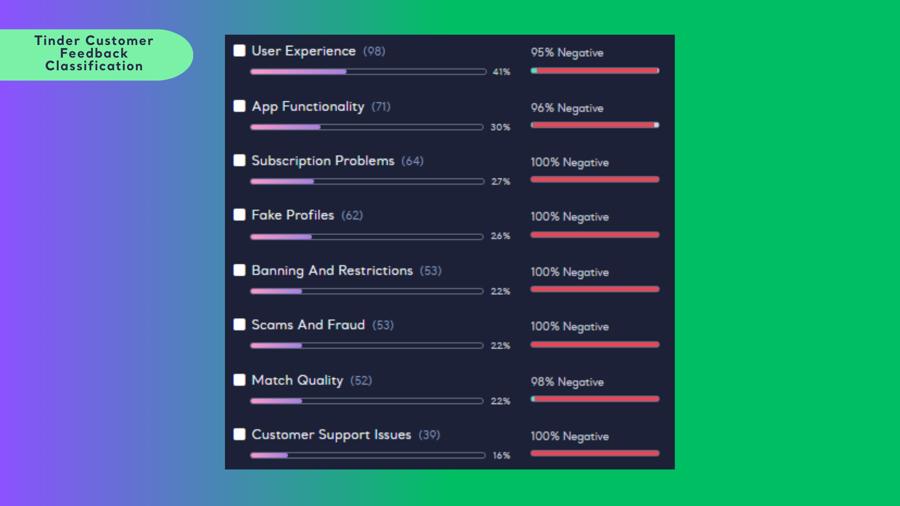
Bumble: A Safe Space with Room for Growth
Bumble's unique approach—where women make the first move—receives strong positive feedback for fostering a safe and encouraging space for dating. Many users appreciate the app's commitment to gender equality and the sense of control it provides. Beyond dating, Bumble has expanded into professional networking with Bumble Bizz, allowing users to connect over careers rather than hobbies. While this feature brings LinkedIn to mind, users appreciate the opportunity to network in a less formal setting. That said, complaints often focus on the algorithm limiting matches and premium memberships not delivering enough value.
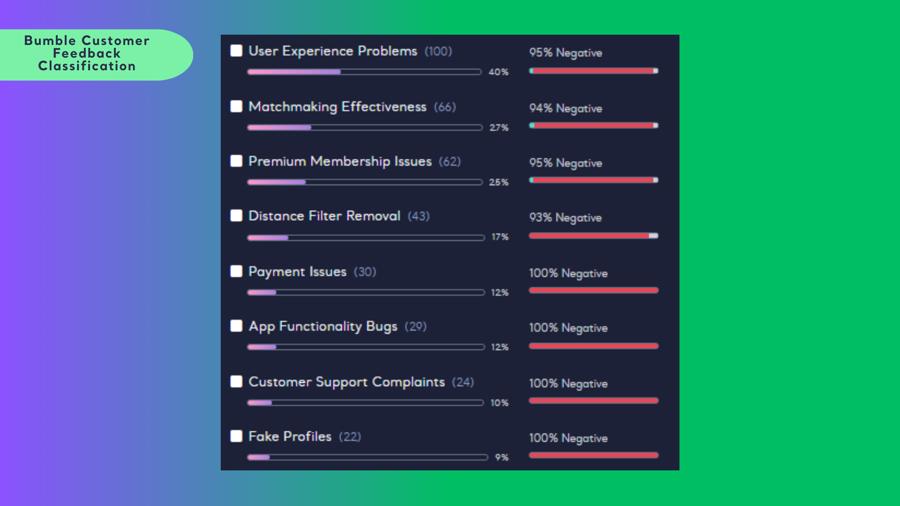
Happn: Turning Chance Encounters into Connections
Happn aims to bring movie-like coincidences into reality by matching users based on location. The idea of reconnecting with someone seen earlier in the day appeals to romantics who believe in fate. If Happn had a slogan, it could be “Happn Loves Coincidences.” (Let's just ignore the fact that it might sound a little too familiar to fans of a certain romantic movie.) While users enjoy the concept, many report low match quality and a high number of fake profiles, making it harder to trust the authenticity of connections.
Surprisingly, not all users turn to dating apps solely for love. Feedback shows that many also use these platforms for friendships, professional networking, and even language learning through conversations with people from different countries. Bumble, with its Bumble Bizz feature, stands out for career-oriented networking, while Tinder users often seek fun chats and event participation. Happn, with its location-based approach, provides opportunities for socializing beyond dating.
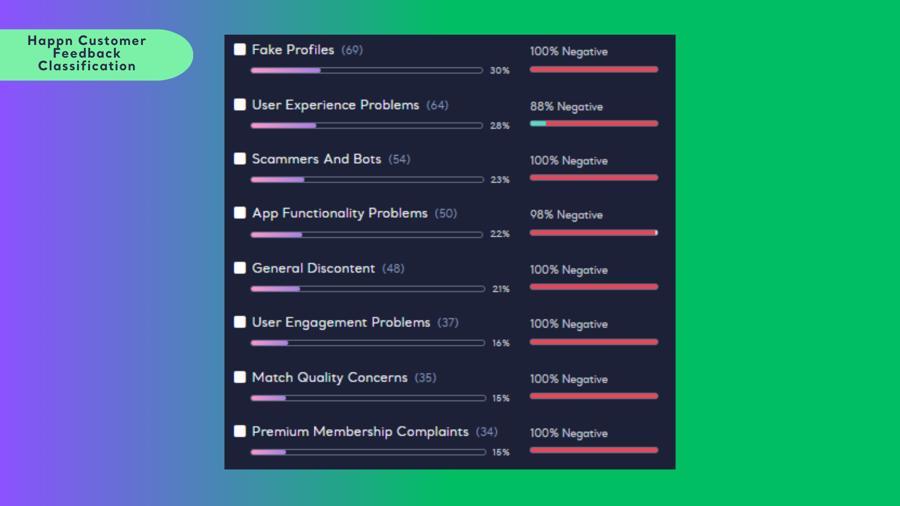
For those who see dating apps as a way to expand their personal and professional circles, these platforms offer more than just potential romantic partners—they help users grow their networks in unexpected ways.
Who Uses Dating Apps and What Matters to Them Most?
Dating apps attract a diverse range of users, each with unique expectations, frustrations, and engagement styles. Based on the customer feedback analysis on Kimola, several distinct user personas emerge, shedding light on what matters most to people when using these platforms. Whether they are premium subscribers feeling shortchanged, skeptical users questioning the app's authenticity, or hopeful romantics searching for true connections, understanding these personas helps paint a clearer picture of modern dating app users.
The Disappointed Premium Member
This user has invested in a premium subscription, expecting exclusive features and better matchmaking. However, their experience is often marked by frustration. They feel scammed by hidden fees, poor matchmaking algorithms, and persistent technical issues. Many of them reach out to customer support only to be met with unhelpful responses, further reinforcing their dissatisfaction. For these users, a transparent pricing structure, improved customer support, and more reliable premium features would be key factors in restoring trust.
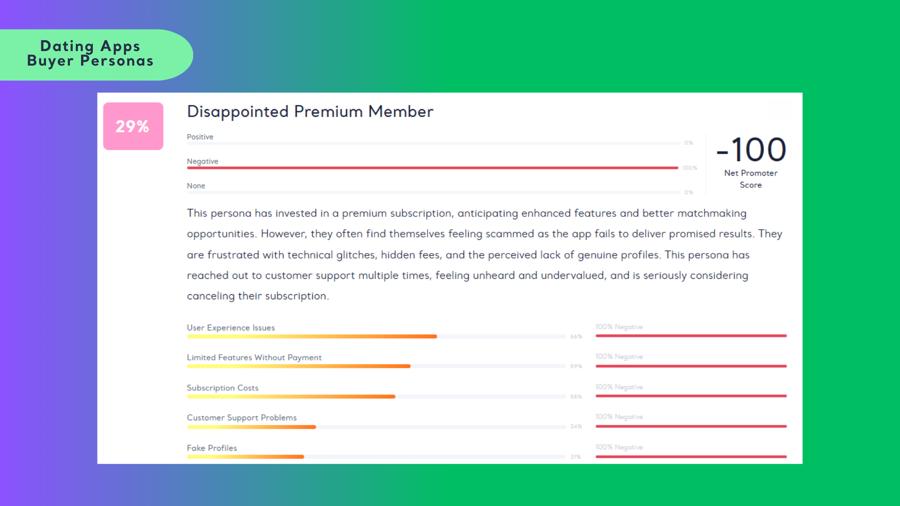
The Frustrated Free User
Not everyone is willing to pay for a dating app right away. This user signs up hoping to explore and connect, only to be met with limited functionality, intrusive ads, and paywalls that block essential features like messaging and viewing likes. They suspect that free accounts are deliberately pushed to upgrade and often voice their frustration over glitches and algorithmic bias toward paying users. What would keep them engaged? A fairer balance between free and premium features, fewer technical issues, and better profile visibility without requiring a financial commitment.
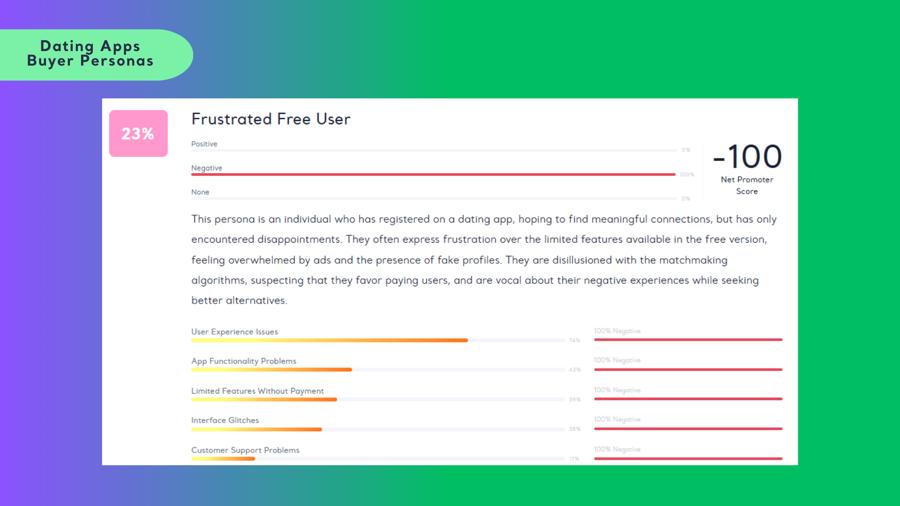
The Skeptical Skeptic
Cautious and analytical, this user approaches dating apps with a high level of doubt. They have likely encountered fake profiles, unresponsive matches, and questionable app mechanics in the past. Their skepticism is fueled by poor user experiences, restrictive free versions, and subscription costs that don't seem justified. These users are vocal in forums and reviews, often influencing others' decisions. To win their trust, dating apps must enhance verification processes, improve user authenticity, and ensure that paying for features actually leads to a better experience.
The Value-Seeking User
For this user, every dollar spent must bring clear benefits. Before subscribing, they meticulously compare dating apps, analyze feature sets, and assess whether premium plans are worth the investment. They are particularly frustrated by unclear pricing, aggressive monetization strategies, and features that don't deliver on their promises. This persona would be more likely to commit if dating apps introduced transparent pricing, flexible payment options, and a visible return on investment for premium memberships.
The Cautious User
While interested in meeting people, this user is highly selective and prioritizes privacy and security. They are wary of fake profiles, spam accounts, and apps that require excessive personal information. They also dislike location inaccuracy, preferring precise control over who can see them and where they appear. Trust is their biggest concern, meaning dating apps must provide better profile verification, stronger privacy controls, and improved location accuracy to gain their confidence.
The Tech-Savvy Millennial
Always on the lookout for the latest trends, this user enjoys experimenting with dating apps and exploring new features. However, their enthusiasm quickly fades when they encounter bugs, crashes, and poor design updates. A smooth, visually appealing interface with responsive performance is essential to keeping them engaged. They also expect clear communication from developers and regular improvements based on user feedback. Dating apps that listen and adapt to their needs will benefit from their loyalty—and their influence on social circles.
The Hopeful Romantic
Despite the ups and downs of online dating, this user believes in love and is willing to keep trying. They approach matches with optimism, looking for deep emotional connections rather than casual encounters. However, their biggest frustration is match expiration, which forces quick interactions instead of allowing relationships to develop naturally. An ideal dating app for them would emphasize meaningful conversations over instant swiping and provide features that encourage long-term engagement rather than rushed interactions.
Across all personas, key themes emerge: authenticity, fair pricing, better user experiences, and meaningful interactions. Users want real people, not bots, subscriptions that offer clear value, and apps that prioritize connections over monetization. Addressing these concerns is crucial for dating platforms looking to retain users and build trust.
With customer insights like those provided by Kimola, dating apps have the opportunity to understand their audience better and create experiences that truly meet their needs—not just in functionality but in fostering real, lasting connections.
The Ideal Dating App: What Users Really Want
The dating app industry has evolved into a massive digital ecosystem, yet many users feel frustrated rather than fulfilled. Based on the customer feedback analysis on Kimola, the most common complaints highlight issues such as fake profiles, high subscription costs, ineffective algorithms, and poor customer support. Users feel that most dating apps prioritize monetization over meaningful connections, leaving them disappointed and looking for alternatives. So, what would an ideal dating app look like? By addressing the most pressing concerns, a truly user-friendly platform could redefine the online dating experience.
A Dating App That Prioritizes Authenticity
One of the most widespread concerns among users is the prevalence of fake profiles and bots, with 23% of reviews mentioning frustration over encountering inauthentic accounts. An ideal dating app must implement multi-layered verification, using phone number verification, social media integration, facial recognition, and AI-powered fraud detection to eliminate fake users. Stronger reporting and moderation systems should ensure that flagged profiles are reviewed promptly, restoring trust in the platform.
Flexible and Transparent Subscription Models
With 28% of users unhappy about subscription costs and feeling pressured to pay for basic features, an ideal dating app should introduce a fair and flexible pricing model. Instead of forcing users into expensive monthly subscriptions, apps could offer pay-per-feature options, one-time purchases for key functionalities, or tiered memberships that allow users to customize their experience. Transparency is key—users should know exactly what they're paying for without misleading promotions or hidden paywalls.
💡 A referral program, such as “Invite a friend and get a discount,” could make subscriptions more appealing while growing the user base organically.
An Algorithm That Works for Users, Not Against Them
Many users express frustration over poor matching algorithms, with complaints about irrelevant profiles, seeing the same people repeatedly, and being shown inactive users. An ideal dating app would prioritize compatibility over quantity, ensuring that users are matched based on genuine interests, lifestyle preferences, and engagement levels.
💡 Additionally, users should be able to refine their matches with more personalized filters. Instead of only selecting broad categories like age and distance, they should be able to match based on activities (e.g., “Find a yoga partner”), communication styles (e.g., “Fast and energetic” vs. “Slow and meaningful”), or shared experiences. This would lead to higher-quality matches rather than an endless cycle of swiping through irrelevant profiles.
A Frictionless, Bug-Free User Experience
One of the most frustrating aspects of current dating apps is glitches, crashes, and slow performance. Users report difficulty logging in, missing matches, disappearing messages, and poor location accuracy. An ideal dating app must be technically robust, ensuring smooth functionality across all devices.
Additionally, users should not feel pressured by arbitrary time limits on conversations. The widespread frustration with match expiration within 24 hours suggests that people want more control over when and how they interact.
💡 Instead of rigid messaging constraints, an ideal app could offer options to extend matches, pause conversations, or set preferred communication windows.
A Customer Support Team That Actually Helps
Poor customer support is a major complaint across dating apps. Users report long wait times, automated responses, and no resolutions for issues like bans, subscription problems, or profile verification failures. An ideal dating app would offer responsive, real-time support through live chat, clear FAQs, and a dedicated team for handling user concerns efficiently. Transparency in enforcement policies, such as clear reasons for bans and easy ways to appeal decisions, would further improve trust in the platform.
A Platform That Goes Beyond Dating
While romance is the main reason people join dating apps, many users also seek friendships, professional networking, and even language exchange opportunities. An ideal app would acknowledge these diverse motivations by providing optional modes for meeting new people beyond romantic interests. Whether through social groups, local event participation, or hobby-based connections, a well-rounded dating app could help users expand their social circles in meaningful ways.
By addressing these core issues, an ideal dating app would not only attract more users but also retain them by providing a frustration-free, enjoyable experience. People don't want to feel tricked into spending money, swiping endlessly through fake profiles, or dealing with technical bugs that ruin potential connections. Instead, they want authenticity, fair pricing, intelligent matching, smooth functionality, and real customer support—a platform that truly understands and values its users.
For dating apps willing to listen to customer feedback and implement these changes, the potential is immense. While many users today feel disillusioned by the current landscape, the demand for a better, more user-centric dating experience has never been higher.
Conclusion & What's Next?
Dating apps have revolutionized the way people connect, but as customer feedback reveals, there are still significant gaps between user expectations and reality. Many users struggle with fake profiles, high subscription costs, algorithmic inefficiencies, and frustrating user experiences. While some are optimistic about finding meaningful connections, others feel disillusioned by platforms that prioritize profit over authentic matchmaking.
An ideal dating app would address these concerns by enhancing verification systems, offering flexible pricing models, refining matching algorithms, and improving customer support. It's clear that users are not just looking for a platform to swipe on—they want a reliable, secure, and engaging space where real connections can thrive.
For businesses in the dating app industry—or any sector that values user experience—customer feedback is a goldmine of insights. Understanding user motivations, frustrations, and behavioral patterns allows companies to make informed, data-driven decisions that improve product development, marketing strategies, and overall customer satisfaction.
Kimola automatically collects customer feedback from major platforms such as the App Store, Google Play, X, Trustpilot, Tripadvisor, Amazon, and Google Business—transforming it into qualitative research reports with thematic analysis, sentiment breakdowns, buyer personas, usage motivations, and key insights.
If you're ready to take your business to the next level—making it more intuitive, accessible, and aligned with your users' expectations—create a free account on Kimola and start analyzing customer feedback instantly. Want a deeper dive? Request a demo with one of our professionals to explore how Kimola's powerful analytics can help you turn user insights into smarter business decisions.
